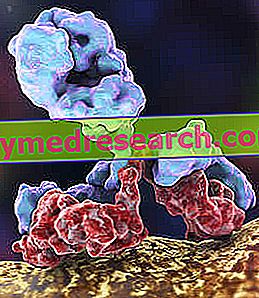Generality
Monoclonal antibodies (or MAb, from the English Monoclonal Antibodies ) are particular types of antibodies, produced with recombinant DNA techniques starting from a single type of immune cell.

Monoclonal antibodies are widely used in clinical settings, both for diagnostic purposes and for therapeutic purposes.
However, before delving into what the uses of these particular proteins are and to better understand their mechanism of action, a small premise on what antibodies are can be useful.
What are antibodies?
Antibodies (or immunoglobulins) are glycoproteins produced by the B lymphocytes of the humoral immune system. These proteins are able to recognize and bind specifically to other types of proteins called "antigens".
The function of antibodies is to recognize and neutralize foreign and / or pathogenic agents, such as, for example, viruses, bacteria or toxins. This is possible thanks to the particular structure of these molecules.
In fact, antibodies are globular proteins with a particular "Y" shape. Within this protein structure there is a so-called constant region and variable regions, corresponding to the arms of the "Y". It is precisely at the level of the variable regions that the specific binding sites for the antigen are found.
Each B lymphocyte is capable of producing millions of antibodies, which in turn can recognize different types of antigens (polyclonal antibodies).
Once the antibody binds to the antigen for which it is specific, the antibody itself activates and gives rise to the immune response that will lead to the elimination of the foreign agent.
Action mechanism
Monoclonal antibodies act with the same mechanism of action just described for polyclonal antibodies.
Monoclonal antibodies, in fact, possess a highly specific affinity for a given type of antigen and bind to it, thus allowing to obtain a marked immune response against that toxin, protein, chemical mediator, malignant cell or pathogen which is the target of therapy.
Classification
Monoclonal antibodies used in therapy can be classified in different ways.
A first subdivision could be the following:
- Monoclonal antibodies naked (ie not conjugated to other molecules);
- Monoclonal antibodies conjugated to drugs or radioactive isotopes.
With the conjugation of one or more drugs to monoclonal antibodies it is possible to direct with extreme precision that same active principle towards the target of interest, avoiding to involve also other districts of the organism. In this way, you can potentially reduce the side effects and increase the chances of therapeutic efficacy.
The conjugation of radioactive isotopes to monoclonal antibodies, on the other hand, is a technique that is used above all in anticancer therapy. More precisely, in these cases we talk about radioimmunotherapy (for more detailed information on this, see the article on "External Radiotherapy and Internal Radiotherapy").
A further classification of monoclonal antibodies can be made according to the use made of it. In fact, as mentioned, these particular glycoproteins can be used both for diagnostic purposes and for therapeutic purposes.
Monoclonal antibodies used in the diagnostic field
As you can easily guess, this type of monoclonal antibodies is used to diagnose the presence of a specific antigen and, if necessary, even to measure its quantity.
Therefore, monoclonal antibodies can be used to detect bacterial or viral agents, particular types of proteins or cells and tumor markers.
It is therefore clear how these molecules can be exploited in clinical laboratories for the diagnosis of pathologies (such as, for example, neoplasms), but not only.
In fact, the monoclonal antibodies used in this area are widely used also in so-called diagnostic kits for domestic use, such as, for example, the well-known pregnancy tests and ovulation tests.
Monoclonal antibodies used in the therapeutic field
There are different types of monoclonal antibodies to be used for therapeutic purposes, as are the targets of therapy and the pathologies for which these molecules are used.
To try to simplify the concept as much as possible, we can divide these active ingredients according to the activity they perform:
- Monoclonal antibodies with anti-inflammatory action : drugs such as infliximab (Remicade®, Remsima®, Inflectra®) and adalimumab (Humira®) belong to this group. These monoclonal antibodies exert an anti-inflammatory action because their antigen is human TNF-α, one of the pro-inflammatory cytokines most involved in the symptomatology of autoimmune inflammatory pathologies, such as, for example, rheumatoid arthritis and arthritis psoriatic.
- Monoclonal antibodies with an immunosuppressive action ; the target of these active ingredients is constituted above all by defense cells such as B lymphocytes and T lymphocytes and by proteins essential for their differentiation and activation, such as interleukin-2.
The drugs used in the treatment of autoimmune diseases and in the prevention of rejection in organ transplants belong to this group of monoclonal antibodies, including rituximab (also used in the treatment of some types of lymphomas) and basiliximab (Simulect®).
Moreover, this group also includes omalizumab (Xolair®), whose target is human IgE and is used in the treatment of allergic asthma.
- Monoclonal antibodies with antitumor action ; there are many active ingredients belonging to this group. The target of these monoclonal antibodies is mainly constituted by fundamental factors for the development of malignant cells, or by proteins that are overexpressed when certain types of tumors are present, as happens, for example, in the case of HER-2 positive breast tumors. In this case, the trastuzumab monoclonal antibody (Herceptin®, Kadcycla®) is used to treat this tumor. Rituximab (MabThera®), cetuximab (Erbitux®) and bevacizumab (Avastin®) also belong to this group of monoclonal antibodies.
Furthermore, there are monoclonal antibodies capable of exerting different activities than those just described. This is the case of abciximab (Reopro®), which has platelet anti-aggregation activity. The antigen of this monoclonal antibody is, in fact, the glycoprotein IIb / IIIa present in platelets and, indeed, involved in the processes of platelet aggregation.
Limits and Side Effects
The side effects that can occur during therapy based on monoclonal antibodies depend on many variables, such as the type of active ingredient chosen, the pathology that is intended to be treated, the conjugation or not of the antibody with other drugs or radioactive isotopes, the general condition and sensitivity of patients towards the same drug.
However, there are limits that all types of monoclonal antibody-based therapy have in common, regardless of the type of active ingredient chosen.
More precisely, we are talking about the high cost of production and the immunogenicity of these drugs. In other words, it may happen that the patient's body develops antibodies itself to counteract the monoclonal antibodies introduced with the therapy, since it recognizes them as foreign agents, thus leading to the ineffectiveness of the treatment.
However, given the high potential of monoclonal antibody-based therapy, research in this area is still in constant development, in an attempt to identify ever more effective molecules with less possible side effects.



